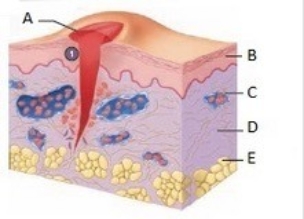A) one dendrite.
B) two dendrites.
C) three dendrites.
D) four dendrites.
E) no dendrites.
G) A) and C)
Correct Answer

verified
Correct Answer
verified
Multiple Choice
Which of the following statements concerning the process of tissue repair is false?
A) In regeneration, destroyed cells are replaced by the same type of cells.
B) In replacement, a new type of tissue develops that eventually results in scar production.
C) Labile cells cannot be replaced by the process of regeneration.
D) Stable cells do not actively replicate after growth but retain the ability to regenerate.
E) Permanent cells have a limited ability to replicate.
G) C) and D)
Correct Answer

verified
Correct Answer
verified
Multiple Choice
In the process of tissue repair, which of the events listed below occurs last?
A) The wound fills with blood and a clot forms.
B) Granulation tissue develops.
C) A scab forms to seal the wound.
D) An inflammatory response occurs.
E) Fibroblasts migrate to the area.
G) B) and E)
Correct Answer

verified
Correct Answer
verified
Multiple Choice
Which type of gland does not have ducts?
A) Exocrine
B) Endocrine
C) Merocrine
D) Apocrine
E) Holocrine
G) A) and D)
Correct Answer

verified
Correct Answer
verified
Multiple Choice
What is the microscopic study of tissues?
A) Anatomy
B) Physiology
C) Pathology
D) Histology
E) Embryology
G) A) and B)
Correct Answer

verified
Correct Answer
verified
Multiple Choice
To determine that a type of epithelium is squamous, which of the following is most important?
A) The number of cell layers
B) The shape of most of the epithelial cells
C) The shape of the most superficial epithelial cells
D) The shape of the basal epithelial cells
E) The shape of the basement membrane
G) All of the above
Correct Answer

verified
Correct Answer
verified
Multiple Choice
Which of the following statements concerning connective tissue is true?
A) Areolar tissue is tightly packed.
B) Dense connective tissue has a fluid matrix.
C) Mast cells are found in abundance in dense connective tissue.
D) Collagen fibers provide strength to dense connective tissue.
E) Elastic tissue is flexible, but not stretchy.
G) A) and B)
Correct Answer

verified
Correct Answer
verified
Multiple Choice
What is formed from granulation tissue?
A) Edema
B) Secondary union
C) Epithelial tissue
D) Scar
F) A) and D)
Correct Answer

verified
Correct Answer
verified
Multiple Choice
Which of the following are considered major manifestations of inflammation? (Check all that apply.)
A) Edema
B) Heat
C) Hemorrhage
D) Pain
E) Redness
G) B) and E)
Correct Answer

verified
Correct Answer
verified
Multiple Choice
Marfan syndrome is a hereditary defect of elastin fibers. People with this syndrome have ________.
A) hyperextensible joints
B) a small cranium
C) elastic bones
D) stronger bones
E) viscous blood
G) C) and D)
Correct Answer

verified
Correct Answer
verified
Multiple Choice
Muscular tissue consists of which type of cells or fibers?
A) Elongated fibers (cells) that are specialized to contract
B) Cells with multiple processes that are specialized to send electrical signals
C) Elongated fibers (cells) surrounded by abundant matrix
D) Spherical cells designed for storage
F) A) and B)
Correct Answer

verified
Correct Answer
verified
Multiple Choice
What is a malignant tumor derived from connective tissue?
A) Melanoma
B) Lymphoma
C) Sarcoma
D) Carcinoma
E) Both "Carcinoma" and "Sarcoma" are correct.
G) None of the above
Correct Answer

verified
Correct Answer
verified
Multiple Choice
Marfan syndrome is a genetic disorder associated with ________ tissue.
A) epithelial
B) connective
C) muscular
D) nervous
E) All choices are correct.
G) A) and C)
Correct Answer

verified
Correct Answer
verified
True/False
Because epithelial tissue is highly vascular, it heals well.
B) False
Correct Answer

verified
Correct Answer
verified
Multiple Choice
The support and protection of neurons are provided by ________.
A) dendrites
B) ligaments
C) glia
D) neurons
E) axons
G) C) and D)
Correct Answer

verified
Correct Answer
verified
Multiple Choice
A tissue sample has the following characteristics: large cells with many processes, one which is very long; smaller cells scattered amongst the larger cells. Which of the following statements accurately identifies the tissue?
A) The tissue is nervous tissue. The large cells are neurons with dendrites and a long axon, and the smaller cells are glia.
B) The tissue is dense irregular connective elastic tissue. The large cells are fibroblasts with attached collagen fibers, and the smaller cells are glia.
C) The tissue is nervous tissue. The large cells are fibroblasts with dendrites and collagen fibers, and the smaller cells are squamous cells.
D) The tissue is dense regular connective tissue. The large cells are neurons with dendrites and a long axon, and the smaller cells are fibroblasts.
F) A) and B)
Correct Answer

verified
Correct Answer
verified
Multiple Choice
 -This is a figure of a skin wound. What does "B" represent?
-This is a figure of a skin wound. What does "B" represent?
A) Dermis
B) Subcutaneous adipose tissue
C) Epidermis
D) Blood vessel
E) Blood clot
G) A) and C)
Correct Answer

verified
Correct Answer
verified
Multiple Choice
Which of the following molecules consists of numerous polysaccharides attached to a protein core?
A) Collagen
B) Proteoglycan
C) Elastin
D) Reticulin
E) Hyaluronic acid
G) B) and C)
Correct Answer

verified
Correct Answer
verified
Multiple Choice
A long, unbranched polysaccharide found in the extracellular matrix of connective tissue is ________.
A) proteoglycan
B) tropocollagen
C) hyaluronic acid
D) chondronectin
F) A) and C)
Correct Answer

verified
Correct Answer
verified
Multiple Choice
Which type of tissue attaches to the underlying muscles and supports the framework for body organs?
A) Adipose tissue
B) Areolar tissue
C) Reticular tissue
D) Epidermal tissue
F) B) and D)
Correct Answer

verified
Correct Answer
verified
Showing 121 - 140 of 208
Related Exams